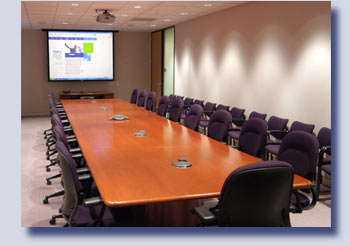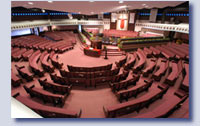
Great conference room photos
![]()
What
makes an AV system photo great?![]()
Letís start by defining the qualities of an effective
AV system photo. ![]()
1.
It captures the feel of the room, enhancing the existing lighting but not
overwhelming it. ![]()
Most
architectural photographers spend a lot of time lighting a given room. The reason
they do this is that the eye is less sensitive to changes in light intensity than
film or a digital sensor. What looks good in person will often look contrasty
and harsh to a camera. So the theory is to light the room so that it looks as
good, or better, on film than it does to the eye. ![]()
I
have to tell you, itís very difficult to get a natural-looking result this way,
and all but the best practitioners end up with something that looks pretty artificial.
Then too, the architect or interior designer has spent a lot more time designing
the installed lighting than any photographer will spend redoing it. ![]()
One
of my friends takes a softer approach with his architectural photography, simply supplementing the roomís
lights with strobes to brighten up the shadows. The trick to this method is managing
the color values of the various types of light involved. But there are ways to
do that.
![]()
The third approach
is to shoot the room at various exposures with the existing lighting, then combine
the results in a multi-layered PhotoShop file. I'll explain how to use this method in detail
later for those who would like to try it.
![]()
2.
It shows the AV to is best advantage. ![]()
It
always annoys me to see a conference room photo with a washed-out, blue-tinted
projected image or an overexposed TV or plasma monitor. Thatís not the way those
screens look if youíre standing in the room. If it was, there would be a lot fewer
systems sold.![]()
The reason
these images look that way in photos is that the brightness and the color temperature
of the screen is almost never the same as the rest of the room and requires different
settings on the camera. Thus, with rare exceptions, the photographer needs to
take a separate exposure for any screen image in the room, then combine the results
later in the computer. ![]()
Of course, it's possible today to fake a screen
image in PhotoShop. That's often necessary, but it's not the best solution. Projectors
and monitors simply can't produce images as clean and variation-free as the computer.
For this reason, simulated images rarely look real.
![]()
![]()

![]()
![]() 3.
It's eyecatching and dramatic.
3.
It's eyecatching and dramatic.
![]()

One
thing that architectural photographers do very well is bring out the drama of
a given room. To do so, they use perspective to its best advantage, often straightening
out the converging lines that occur naturally but are much more noticeable in
a photograph than to the eye. ![]()
It
used to take a view camera, with its ability to tilt the lens and film back independently,
to control this problem, but now anyone can do it in PhotoShop. PhotoShop plug-ins
can also control barrel distortion, an unnatural curvature of objects due to the
use of wide-angle lenses.![]()
Used together, these software tools can help greatly
both in producing dramatic views of meeting rooms and in making straightforward
views more effective. ![]()
If
you plan to hire a photographer to shoot your latest system work, make sure he
understands that you expect dramatic, eye-catching images that highlight the look
and lighting of the actual room and show the AV system to its best advantage.
![]()
If you plan to take the photos in-house, keep
reading for my explanation of how to do it.
![]()
Next:
shooting your own AV system photos